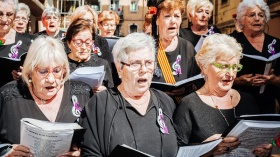Street groups
When the street was reclaimed as a recreational space, after the long Franco dictatorship, a lot of festival activity became concentrated there and it gained a new feeling and provided a ritual for the celebrations. Cercavila processions around the streets, groups of entertainers, and seguici parades, where music plays a very important part, take up a significant segment of the programme in the festes majors. The gralla has come to the fore as the perfect instrument for the streets. It had been kept alive in the the counties of Camp de Tarragona, Garraf and Penedès, undoubtedly due to its link to the world of the casteller, the human tower builders. At the same time, gralla groups were set up to accompany gegants (giants), bèsties (beasts), and popular dances.
At the end of the 1970s and 80s, the gralla also took hold in Barcelona, and groups began to form. Some, like those in the Gràcia neighbourhood, copied the bands from around Sitges and set up schools, such as the Escola de Grallers i Timbals de Gràcia.
With the passing of time and the training of new musicians, in which the Aula de Música Tradicional i Popular played an important role, the groups increased their repertoires, the players got better, and the instruments became more diverse. Today, the gralla, although still the most numerous, shares space with sacs de gemecs (a kind of bagpipe), flabiol flutes, brass fiscorns, and its cousins the tarotes, tibles and tenores.











